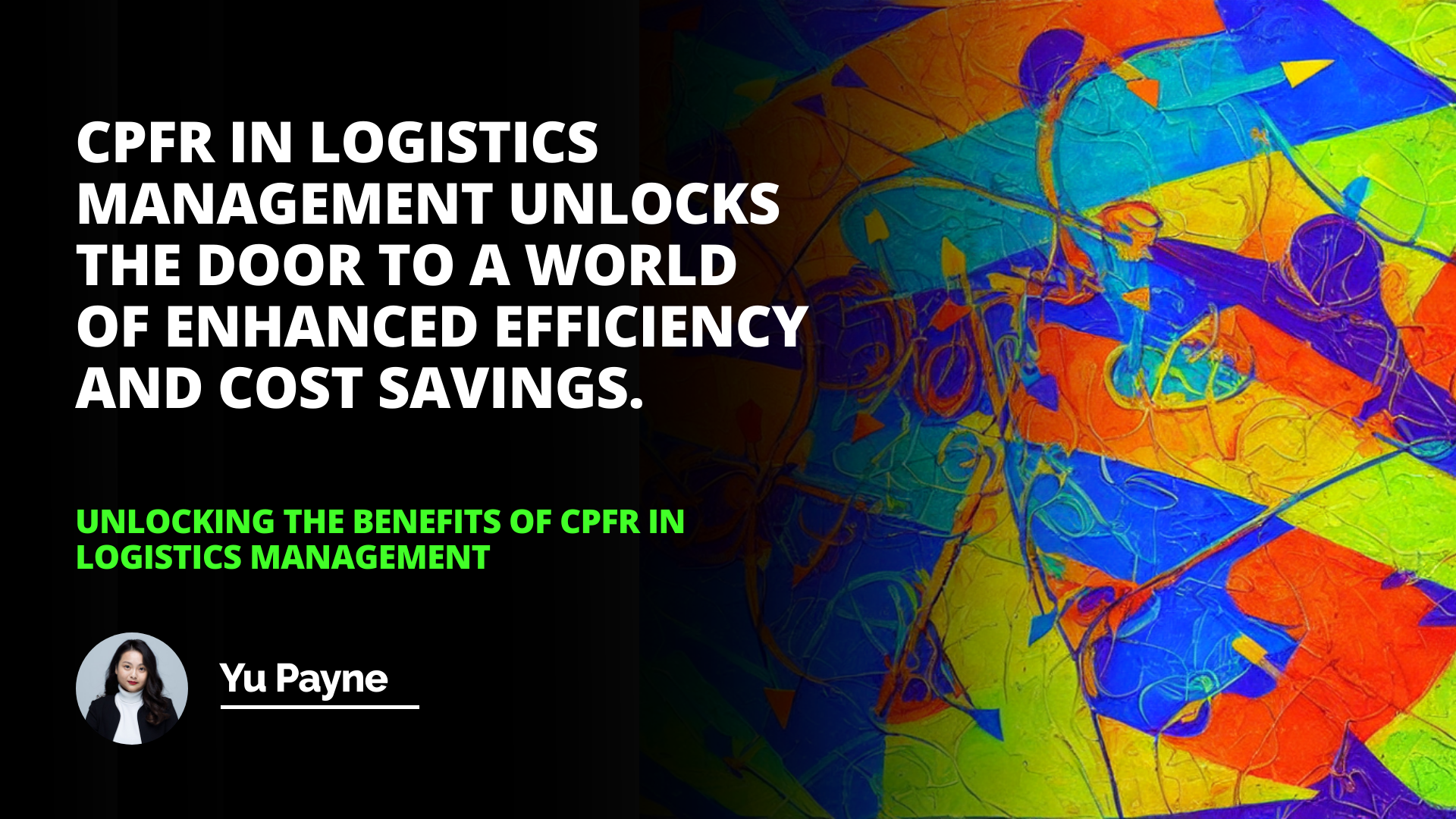
Introduction to CPFR
Benefits of CPFR in Logistics Management
Challenges in Implementing CPFR
Key Components of CPFR
Conclusion and Recommendations
Collaborative Planning, Forecasting, and Replenishment (CPFR) is an innovative supply chain management technique designed to optimize the planning, forecasting, and replenishment process. It is a collaborative approach that combines the strengths of both manufacturers and retailers to create a more efficient and effective supply chain. Many organizations around the world have adopted CPFR as a way to reduce costs and improve customer service levels.
Benefits of CPFR in Logistics Management
CPFR in logistics management can provide numerous benefits, including improved customer service, increased profitability and cost savings, reduced inventory levels, and improved supply chain visibility. By utilizing the collaborative approach of CPFR, manufacturers and retailers can work together to align their operations better, leading to improved customer service and increased profitability.
Additionally, CPFR can help to reduce inventory levels, as manufacturers and retailers can agree on accurate forecasts and adjust orders accordingly. This can help to streamline the supply chain and reduce the amount of unnecessary inventory. CPFR also provides improved supply chain visibility, enabling manufacturers and retailers to gain better insights into the entire supply chain process.
Challenges in Implementing CPFR
While CPFR can provide numerous benefits, it is essential to note that a few challenges are associated with implementing CPFR. One of the primary challenges is the need for strong collaboration between manufacturers and retailers. For CPFR to succeed, both parties must be willing to work together and share information. Additionally, there is a need for significant investments in technology and data systems, which can be costly for some organizations.
Key Components of CPFR
In order to successfully implement CPFR, several vital components must be addressed. These components include data sharing, information systems, collaboration, and process management. Data sharing is essential for CPFR, enabling manufacturers and retailers to access and share information in real-time.
Additionally, information systems must be in place to facilitate data sharing and allow for accurate forecasting and replenishment. Collaboration is also crucial, allowing manufacturers and retailers to work together to create more efficient supply chains. Finally, process management is essential to ensure that the CPFR process runs smoothly and efficiently.
Conclusion and Recommendations
Overall, CPFR is a powerful tool that can be used to optimize the logistics management process. By utilizing the collaborative approach of CPFR, organizations can reduce costs, improve customer service, and increase profitability. However, it is essential to note that a few challenges are associated with implementing CPFR, such as the need for strong collaboration and significant investments in technology and data systems.
To successfully implement CPFR, organizations should focus on the critical components of data sharing, information systems, collaboration, and process management. With the right strategy and support, organizations can unlock the benefits of CPFR and reap the rewards of an optimized logistics management process.
CPFR in logistics management unlocks the door to a world of enhanced efficiency and cost savings
Frequently Asked Questions
What are the benefits of using CPFR in logistics management?
Collaborative Planning, Forecasting, and Replenishment (CPFR) is an essential tool for logistics management. It is a process that enables organizations to jointly plan and manage the supply chain process to increase efficiency. CPFR has become increasingly popular in recent years due to its ability to provide increased visibility across the supply chain and better collaboration between partners. This article will discuss the various benefits of using CPFR in logistics management.
The first benefit of using CPFR is improved visibility across the supply chain. By utilizing this process, organizations can track their inventory more accurately, which allows them to respond to customer demand more effectively. This enhanced visibility also allows organizations to adjust their inventory levels quickly in response to changes in customer demand or market conditions. Additionally, CPFR provides organizations with a better understanding of their customer’s needs and preferences, which can help them make better decisions about how best to meet those needs.
Another benefit of CPFR has improved collaboration between partners within the supply chain. This allows all parties involved to be aware of changes in inventory levels or customer demands quickly and accurately, allowing them to adjust their plans accordingly. Additionally, this improved collaboration can lead to cost savings by eliminating unnecessary duplication of efforts or resources and reducing waste caused by errors or delays within the supply chain.
Finally, leveraging CPFR can improve customer satisfaction due to an increased ability for organizations within the supply chain network to respond quickly and accurately when customers make orders or other requests for products or services. By having access to real-time data about inventory levels and customer demands, organizations can utilize data-driven decision-making for more efficient planning and execution processes, leading directly to higher customer satisfaction rates overall as orders are fulfilled more promptly than before the CPFR processes were implemented.
In conclusion, it is clear that there are many benefits associated with implementing a collaborative planning forecasting replenishment system in logistics management systems, such as increased visibility across the supply chain; reduced costs associated with duplication of efforts; improved collaboration among partners; and finally, increased customer satisfaction rates due more excellent responsiveness capabilities when fulfilling orders or requests from customers. CPFR offers numerous advantages that should be noticed by any organization looking for effective ways to optimize its logistics operations.
What challenges are associated with implementing CPFR?
Implementing Collaborative Planning, Forecasting, and Replenishment (CPFR) has become increasingly popular as organizations strive to improve their supply chain operations and customer service levels. However, while CPFR can benefit an organization significantly, it also presents several challenges that must be addressed to ensure successful implementation.
One of the primary challenges associated with implementing CPFR is coordinating multiple trading partners' activities. CPFR requires sharing information between multiple trading partners, including manufacturers, retailers, distributors, and logistics providers. This requires a high level of collaboration and communication between trading partners and a willingness to share data to ensure that all parties operate with the same information. Additionally, the different trading partners may have different systems and processes in place, making it challenging to ensure that all parties accurately share and understand the data.
Another challenge associated with CPFR implementation is reliable and accurate data. CPFR relies on accurate data to make informed inventory levels and customer demand decisions. However, gathering and maintaining accurate data takes time and effort, particularly in dynamic markets where demand can fluctuate quickly. In addition, the data must be stored securely and reliably to ensure it is not compromised or corrupted.
Finally, CPFR requires organizations to change their existing processes and procedures to accommodate the new system. This can be a complex process, as organizations must identify the existing processes that need to be modified or replaced to accommodate the new system. Additionally, organizations must ensure that the new processes and procedures are appropriately documented and communicated to all stakeholders.
In conclusion, the implementation of CPFR presents several challenges that must be addressed to ensure successful implementation. These challenges include the need to coordinate the activities of multiple trading partners, the need for reliable and accurate data, and the need to modify or replace existing processes and procedures. Therefore, organizations must be prepared to address these challenges to ensure the CPFR system is implemented correctly and used effectively.
How can manufacturers and retailers collaborate to gain the most benefit from CPFR?
Collaborative Planning, Forecasting, and Replenishment (CPFR) is a supply chain system that facilitates cooperation between manufacturers and retailers. This strategy enables the two parties to work together to develop more accurate forecasts, more efficient replenishment systems, and better inventory management. By collaborating on these areas, manufacturers and retailers can benefit the most from CPFR.
Manufacturers can benefit from CPFR through improved forecast accuracy. When both parties collaborate on forecasts, they can use each other's data points to create more accurate demand predictions. This enables suppliers to order the right product at the right time, leading to fewer stock-outs and better customer service. Furthermore, since CPFR allows for greater visibility into demand patterns across multiple channels (e-commerce sites, brick-and-mortar stores), suppliers can use this data to optimize their production schedules to meet customer needs promptly.
Retailers also stand to gain from CPFR by optimizing their inventory management systems. Through collaborative forecasting with suppliers, retailers receive up-to-date information regarding upcoming supply shortages or excesses that may be occurring in their stores or warehouses. Furthermore, retailers can use this data for replenishing stock and allocating inventory across different channels to maximize sales opportunities across all platforms. Additionally, through collaboration with suppliers through CPFR systems, retailers can reduce costs associated with shipping and warehousing by ensuring that only necessary amounts of product are ordered at appropriate times throughout the year.
Finally, manufacturers and retailers can benefit from CPFR by improving communication regarding potential problems or issues within either party's supply chain system. By working together collaboratively, they can quickly identify any potential issues so they may be addressed before they become more significant problems. This improved communication allows both parties involved in CPFR collaborations to gain enhanced visibility into each other's operations, leading to increased efficiency and reduced risk involved with running a retail or manufacturing business.
In conclusion, manufacturers and retailers have many potential benefits when engaging in Collaborative Planning, Forecasting, & Replenishment (CPFR) collaborations. Manufacturers gain through improved forecast accuracy, while Retailers gain benefits such as optimized inventory management & reduced shipping & warehousing costs. Ultimately though, the most significant benefit of engaging in such collaborations comes from the improved communication between the two parties, which leads to increased efficiency & reduced risk involved with running retail/manufacturing businesses.


